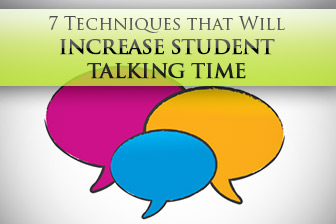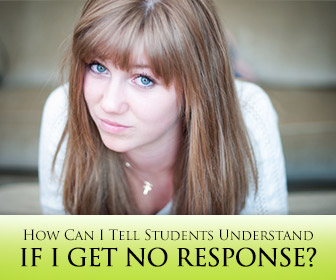7 Techniques that Will Increase Student Talking Time – Exponentially!


"I am currently teaching English in Japan, and the students are so shy. It is very difficult to get a response from them so I cannot tell if they understand or not.*"
The ESL teacher asks a question and is met with nothing but blank stares and empty silence. She repeats the question, and there’s more silence. It’s not a pretty picture. But this scenario is, fortunately for us, quite rare. In most cases, there’s at least one student who raises his/her hand and saves us from the awkward hush. But what if you have a classroom full of students who don’t respond? How can you get them to participate? More importantly, how do you even know they understand what you’re saying? Well, you won’t know unless you get them to respond.
If it’s the first day of class, my answer is simple: give them time to warm up to you. Students are typically less communicative when they barely know you and the type of teacher you are. So give them some time. However, if several days have gone by and you still have a class full of tight-lipped students, you might want to try some of these strategies.

A lot of ESL students don’t respond to your questions because they’re too shy/insecure to speak up in front of the entire class. So, if you give a set of instructions or a task and you can’t be sure everyone has understood, tell them you’ll be walking around the classroom to help. Instruct students to raise their hand if there is something they haven’t understood. Walk directly to the student’s desk to answer his/her question. They will most likely feel more comfortable asking you a question “in private”.
For speaking tasks, shy students will feel more comfortable role-playing with a partner instead of in front the entire class. You’ll most likely get more response and a more varied use of language.
Long periods of silence are awkward for students, too. You’ll need to do something to break through the silence, and there’s nothing better for that than laughter. Laughter is spontaneous and infectious – students may be able to control their replies, but they can’t control their laughter. It also creates a more relaxed atmosphere. If you say something ridiculous out loud, they won’t be afraid of ridicule themselves.
So make a joke to lighten the mood: Wow… I think I just heard a pin drop in the classroom upstairs. Or come up with a crazy proposition: I’m going to ask that question again. The first student who raises his/her hand gets a coupon for a free muffin at (insert name of popular fast food restaurant/coffee shop). Or an even crazier one: If one of you tries to answer my question, I’m going to do a little tap dance right here in front of the class. Naturally, you’ll want to convey that all of this is in good fun, and the right facial expressions and tone of voice should tell them that. Whatever jokes you make or funny stunts you pull, just be sure it’s not offensive to your student’s culture.
When dealing with unresponsive young learners, puppets are excellent tools. Children are usually more willing to answer a puppet’s questions than your own. Plus, there’s the added benefit of making voices and giving it a comic effect, which will make them laugh and feel more relaxed.
You want to get into the topic of routines, and you ask your class: What time do you get up in the morning? No answer. But then you use your power of keen observation and notice that one of your students has a Superman t-shirt. So you ask: What time does Superman get up? What do you think? Does he even sleep? Students are also typically more responsive when the focus shifts from them to other people, especially if they are fictional characters.
You might be tempted to point to a single student and call on him/her to answer your question. But I don’t recommend putting an unresponsive student on the spot like this. They might be able to squeak out a yes or no, but it won’t be helpful if you want to establish good rapport with your students.
As I mentioned earlier, the best thing you can do is give them time. If you take the time to get to know them, you’ll see what strategies you can use to get them to speak. If you create a supportive, relaxed atmosphere where your students feel they won’t be judged or put under pressure, they’ll open up sooner than you think.
* This question was sent in from a real ESL teacher, just like you! Have a question of your own? Feel free to share it in the comments below. Or tweet your question to @busyteacher_org with the hashtag #ESLTeachersAsk. Your question might get picked and featured in an article!